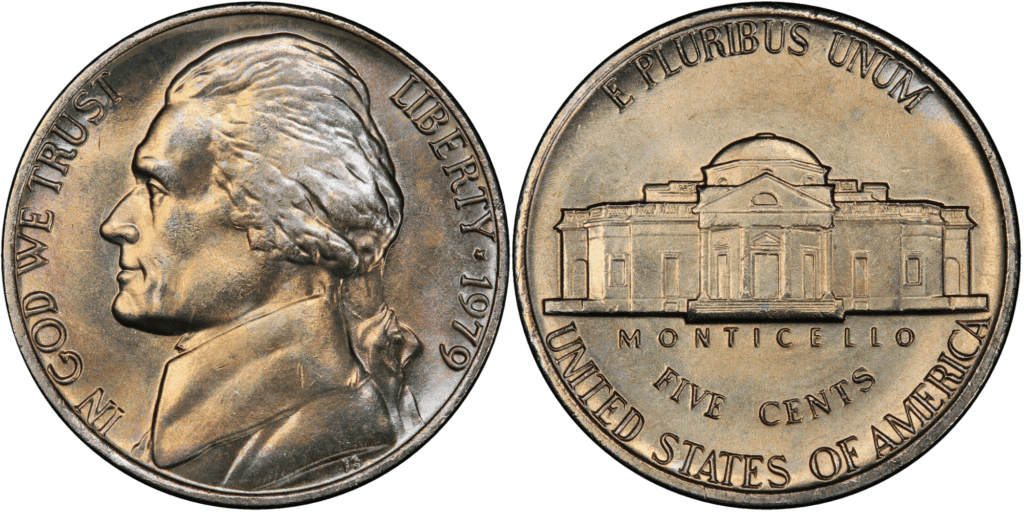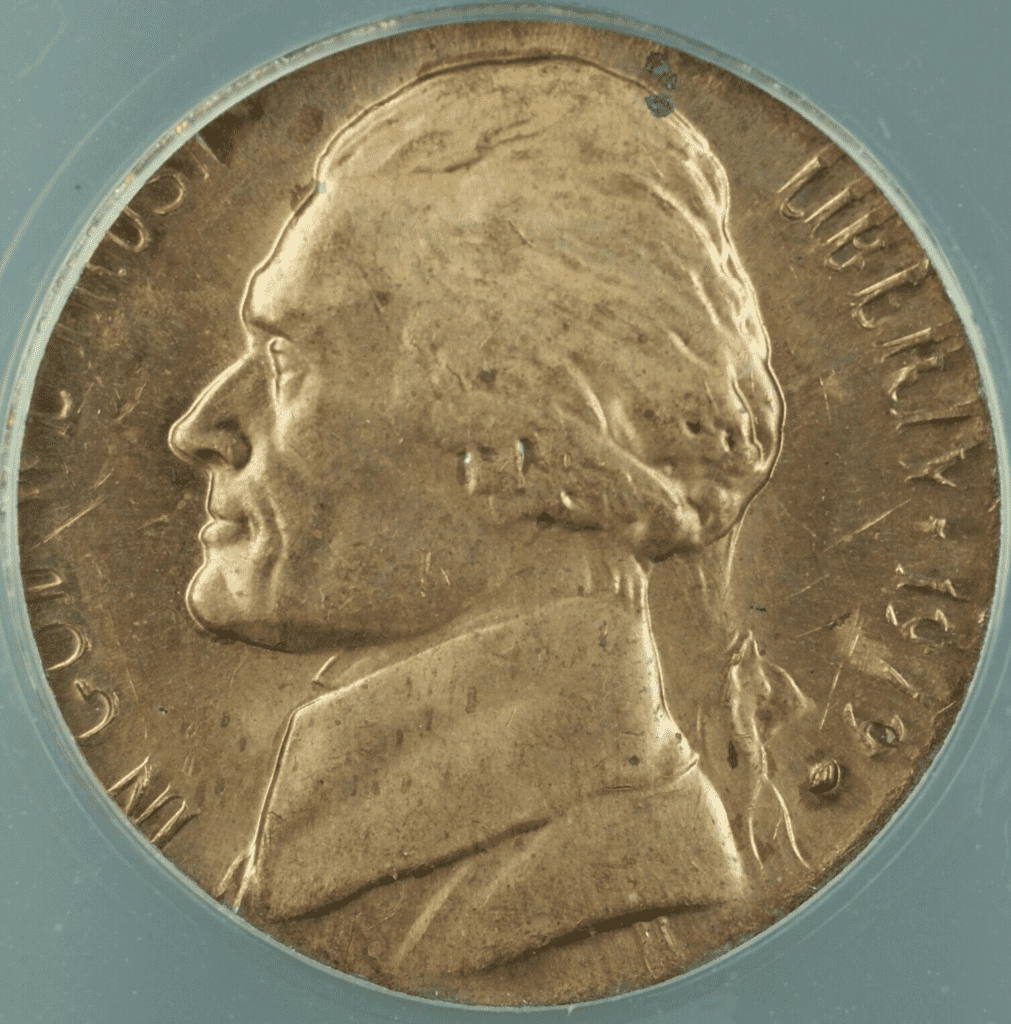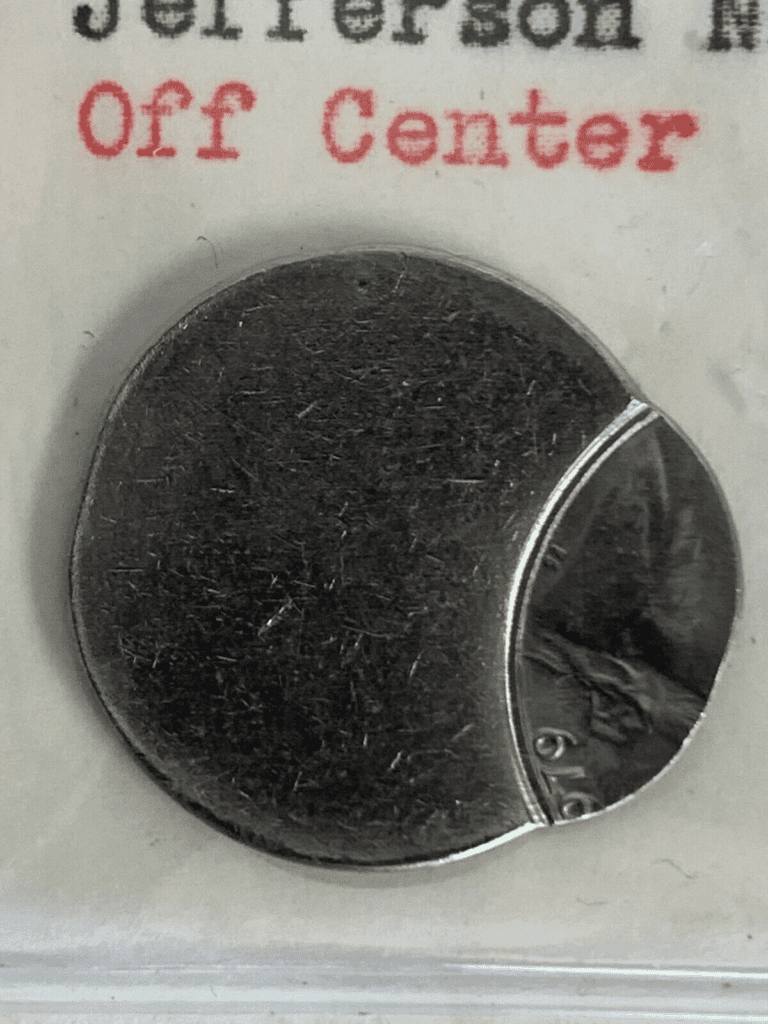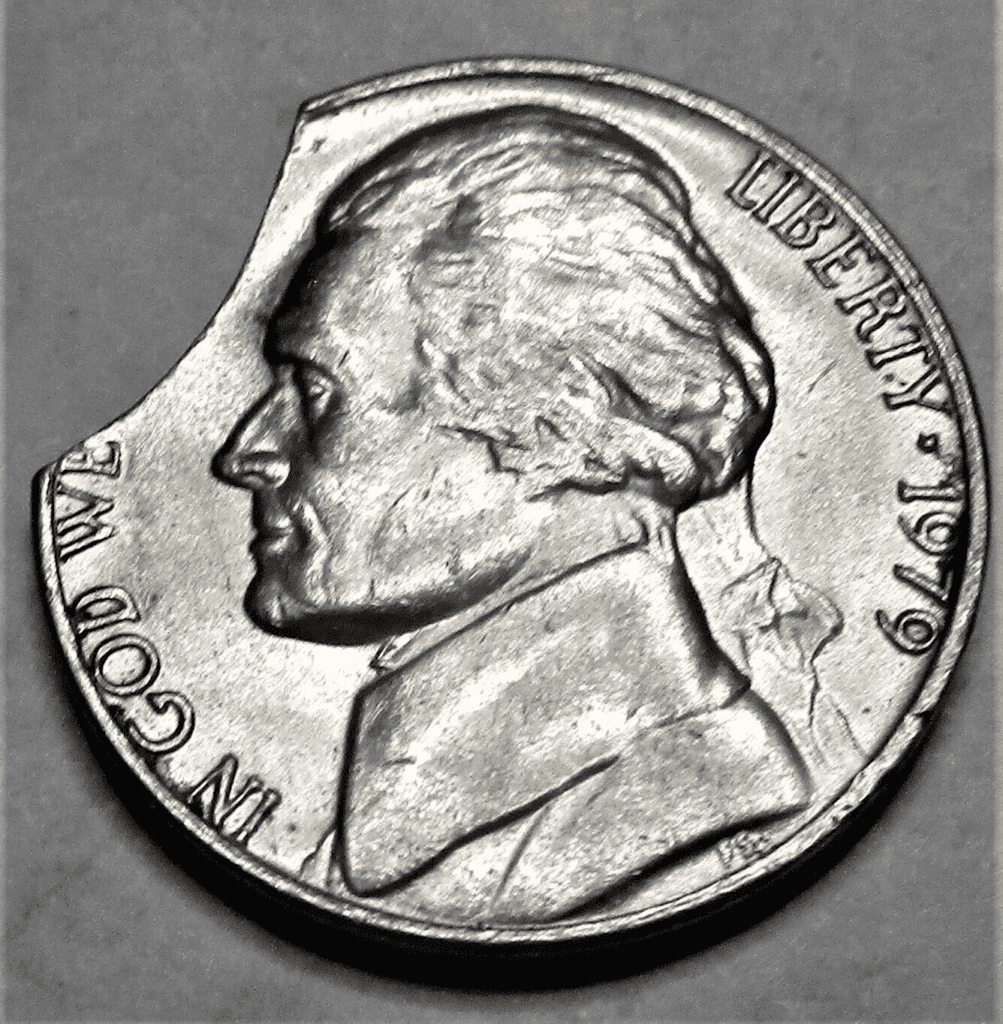What Is A 1979 Jefferson Nickel Made Of?
The 1979 Jefferson nickel comprises 75% copper and 25% nickel. It has a mass of 5.00 grams and a diameter of 21.21 mm. It is 1.95 thick. There are also those nickels referred to as “war nickels,” which are from 1942 to 1945. From 1952 to 1945, the composition of nickel was 56% copper, 35% silver, and 9% manganese.

photo source: PCGS
When it comes to design, the 1979 nickel features the bust of Thomas Jefferson facing left, which was designed by Jamie Franki. The inscription includes the following:
- IN GOD WE TRUST
- LIBERTY
- 1979
- JF (initials of Jamie Franki)
The reverse includes the front view of Monticello, the mansion of Jefferson. The design was made by Felix Schlag. Inscriptions include the following:
- E PLURIBUS UNUM
- MONTICELLO
- FIVE CENTS
- UNITED STATES OF AMERICA
The nickel was first struck in 1866 and its face value is 5 cents or $0.05. The silver half-dime was first used from 1782 to 1873. Due to the American Civil War, the government was forced to remove gold and silver from the coins.
From there, five-cent fractional currency notes were used, but they were eventually abolished. The reintroduction of the five-cent coin happened after the successful introduction of two-cent and three-cent coins.
The first five-cent features the Shield design, which was struck from 1866 to 1883. The Shield nickel was replaced by the Liberty Head nickel in 1883 then by the Buffalo nickel in 1913. Finally, in 1938, the Jefferson nickel was introduced in its modern form.
Due to inflation, it costs more than 5 cents to produce a nickel. The U.S. Mint is currently looking for ways to reduce the cost and continue the production of nickel.
1979 Jefferson Nickel Varieties
There are different types of 1979 Jefferson nickels. They differ primarily due to their mint marks. There are also those nickels with errors, which make them unique.
1979 P Nickel (No Mint Mark)
Edge: Smooth
Mint Mark: No mint mark
Place of minting: Philadelphia
Year of minting: 1979
Face Value: $0.05 (fifty cents)
Price: $0.28 to $3.30 (or more)
Quantity produced: 463,188,000
Designer: Felix Schlag
Composition: 75% copper and 25% nickel
Mass: 5 grams
Diameter: 21.21 mm
Thickness: 1.95 mm

photo source: USA Coin Book
The 1979 P nickel was made in the Philadelphia Mint. There were more than 463 million 1979 P nickels produced. If you have one of these coins, you can sell them for $0.28 to $3.30.
1979 D Nickel
Edge: Smooth
Mint Mark: D
Place of minting: Denver
Year of minting: 1979
Face Value: $0.05 (fifty cents)
Price: $0.28 to $4.52 (or more)
Quantity produced: 325,867,672
Designer: Felix Schlag
Composition: 75% copper and 25% nickel
Mass: 5 grams
Diameter: 21.21 mm
Thickness: 1.95 mm

photo source: USA Coin Book
The Denver Mint produced almost 326 million 1979 D Jefferson nickels. You can buy or sell these coins for up to $4.52.
1979 S Nickel
Edge: Smooth
Mint Mark: S
Place of minting: San Francisco
Year of minting: 1979
Face Value: $0.05 (fifty cents)
Price: $0.05 to $3.50 (or more)
Quantity produced: 3,677,175
Designer: Felix Schlag
Composition: 75% copper and 25% nickel
Mass: 5 grams
Diameter: 21.21 mm
Thickness: 1.95 mm
The 1979 S nickels were produced in the San Francisco Mint. These coins were a proof version. This means that the coins are shinier and more attractive than the coins produced in Denver and Philadelphia Mint.
It takes a lot of time and energy to produce proof coins. Thus, there were only about 3.6 million 1979 S nickel coins produced by the San Francisco Mint.
There are two types of 1979 S nickels. These are the following:
1979 S Jefferson Nickels: Type 1 Filled S

photo source: USA Coin Book
The mint mark S is partially filled. It isn’t that pronounced.
1979 S Jefferson Nickels: Type 2 Clear S

photo source: USA Coin Book
As you can see above, the type 2 1979 Jefferson nickels are similar to the type one. The only huge difference is the mint mark “S.” It is clearer and more detailed.
List of errors
Not all 1979 nickels are made perfectly. Some of them were made with errors. Just a single and minor problem anywhere in the minting process can lead to an error in the production of the nickels.
Some of the most common errors include the following:
- Off-center error
- Broadstrike error
- Wrong planchet
- Clipped planchet
- Die clash
- Brokerage
Here’s an example of a 1979 nickel struck on a penny blank planchet:

photo source: eBay
Here’s another example of an off-center error made in 1979 nickel.

photo source: eBay
Below is an image of a 1979 nickel with a clipped planchet:

photo source: eBay
Although these coins look abnormal, they are among the 1979 nickel coins that are worth the most. The error in these coins makes them rare and valuable.
How Much Is A 1979 Jefferson Nickel Worth Today?
The 1979 Jefferson nickel’s face value is five cents. If you’re going to try and sell it, you may not be able to sell it for more, but for less due to inflation.
The melt value is $0.0573. However, if you have the rare ones of the 1979 Jefferson nickel, then you might be able to earn a few hundred to a thousand bucks.
To give you an idea, here’s a table to give you the usual pricing of a 1979 Jefferson nickel:
| Coin | Condition | Grade | Price |
| Ordinary 1979 Jefferson nickel | Circulated | Not graded | $0.05 |
| 1979 P and D Jefferson nickel | Uncirculated | MS 60 | $0.28 |
| 1979 P Jefferson nickel | Uncirculated | MS 65 | $3.30 |
| 1979 P Jefferson nickel | Uncirculated | MS 65 | $4.52 |
| 1979 S Jefferson nickel (type 1) | Uncirculated | PR 65 | $3.30 |
| 1979 S Jefferson nickel (type 2) | Uncirculated | PR 65 | $4.52 |
How Does The Grading System Work?
The Sheldon Scale is used by numismatists to provide a numerical value to coins. The Sheldon Scale goes from poor (P-1) to perfect mint state (P-1) (MS-70). Coins were originally evaluated using words to reflect their condition (Good, Fair, Excellent, Etc.). Unfortunately, coin collectors and dealers had different ideas about what each of these terms represent.
Professional numismatists joined together in the 1970s and established CoinGrading standards. These numismatists now assign grades at key places on the seventy-point scale, using the most regularly utilized numeric points in conjunction with the original adjective grade. The following are the most common coin grades:
-
-
- (P-1) Poor – Indistinguishable and probably damaged; if used, must have a date and mintmark; otherwise, rather battered.
- (FR-2) Fair – Nearly smooth, but without the damage that a coin graded Poor often possesses. The coin must have enough detail to be identified.
- (G-4) Fair – Inscriptions have merged into the rims in some areas, and important elements have been mostly erased.
- (VG-8) Very Good- A little weathered, but all of the primary design elements are visible, albeit faintly. There is little if any, central detail left.
- (F-12) Good – The item is very worn, yet the wear is even, and the overall design details stand out clearly. Rims are almost completely isolated from the field.
- (VF-20) Very Fine – Moderately weathered, with some finer features still visible. The motto or all letters of LIBERTY are readable. Both sides of the coin have entire rims that are separated from the field.
- (EF-40) Extremely Fine – Gently used; all gadgets are visible, and the most important ones are bold. The finer details are bold and clear, however, light wear may be seen.
- (AU-50) Uncirculated – Slight evidence of wear on the coin’s design’s high points; may have contact marks; eye appeal should be adequate.
- (AU-58) Uncirculated Choice – Slight traces of wear, no severe contact marks, almost full mint shine, and great eye appeal.
- (MS-60) Mint State Basal – Strictly uncirculated; no indication of wear on the coin’s highest points, but an unsightly coin with reduced luster, visible contact marks, hairlines, and other flaws.
- (MS-63) Mint State Acceptable – Uncirculated, but with contact scratches and nicks, little reduced shine, but otherwise appealing appearance. The strike is weak to average.
- (MS-65) Mint State Choice – Uncirculated with great mint shine, very little contact blemishes, and exceptional eye appeal. The strike is unusually severe.
- (MS-68) Mint State Premium Quality – Uncirculated with superb luster, no obvious contact marks to the naked eye, and exceptional eye appeal. The strike is quick and appealing.
- (MS-69) Almost Perfect Mint State – Uncirculated with perfect brilliance, a sharp and appealing strike, and extremely good eye appeal. A near-perfect coin with minor imperfections in the planchet, strike, and contact markings (seen only under 8x magnification).
- (MS-70) Mint State Perfect – Under 8x magnification, there are no tiny imperfections discernible; the strike is crisp, and the coin is perfectly centered on a beautiful planchet. Rarely seen on a coin, this coin is bright and whole, with original luster and exceptional eye appeal.
-
Where To Buy Or Sell 1979 Jefferson Nickels?
In this modern time, there are a lot of places where you can buy or sell 1979 Jefferson nickels. In most cases, if you find a place where to buy nickels, they also sell them. So, it’s a one-stop shop for you.
One of the best places for you to buy and sell 1979 Jefferson nickels would be coin shops and auction houses. These places could even offer you rare coins. You can talk to the attendant or owner to learn more about coin collection.
Aside from brick-and-mortar shops, you can go online. You can quickly do a Google search for 1979 Jefferson nickels. In most cases, you’ll get results from Amazon, eBay, and Etsy. These are some of the best places where you can buy and sell 1979 five-cent coins.
FAQ
Where is the mint mark on a 1979 Jefferson nickel?
The mint mark on a 1979 Jefferson nickel can be found on the obverse side, just below the 1979 date.
What nickels have the most silver?
The “war nickels,” which were produced from 1942 to 1945, are considered to be the nickels with the most silver. These coins were made of 35% silver. The rest of the composition includes 56% copper and 9% manganese.
What are the key dates to look for in nickels?
There are nickel series that are more valuable than others. Due to some unique attributes, the nickels dated 1939, 1942, and 1950 are considered to be the most valuable series of nickels.
What Jefferson nickels are worth keeping?
The Jefferson nickels worth keeping would be the ones with great preservation, eye appeal, and rarity. For example, nickels made from 1942 to 1945 are considered to be rare and more valuable than other nickel coins. If you have well-preserved coins from these years, you can learn a lot from them.
What is a 1979 Canadian nickel worth?
The 1979 Canadian nickel has the same worth as its face value, which is $0.05 CAD. However, its melt value is slightly higher, which is $0.12 CAD.








